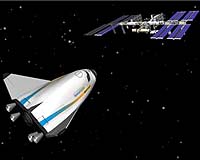 |
Moorestown NJ (SPX) Feb 08, 2011 The U.S. Air Force awarded Lockheed Martin a $107 million follow-on contract for the next phase of Space Fence, a program that will increase space situational awareness and enhance safety for both manned and unmanned space operations. Under the 18-month contract, Lockheed Martin will further develop and prototype its ground-based radar system design in preparation for a final Space Fence production contract next year. Space Fence will replace the existing Air Force Space Surveillance System, or VHF Fence, which has been in service since the early 1960s. The higher wave frequency of the new Space Fence radars will allow for the detection of much smaller microsatellites and debris than the current systems allow. "The proliferation of orbital objects, including rocket debris and satellites, threatens our daily use of space-based technology and its valuable services, such as electronic navigation, satellite broadcasting and medical research," said John Morse, Lockheed Martin Space Fence program director. "Our Space Fence design will provide the Air Force with more time to react to events potentially impacting our space assets and missions - such as collisions with space debris - before they happen." Space Fence will field two or three high-power, S-band ground-based radars to provide the Air Force with uncued detection, tracking, accurate measurement and cataloging of resident space objects, primarily in low-earth orbit. The current VHF system is located in the continental U.S., whereas the Space Fence radars will be located at strategic sites around the world to expand global surveillance coverage into the Southern hemisphere. In June 2009, Lockheed Martin was one of three industry teams awarded a $30 million contract to begin concept development for Space Fence. During the recent system design review phase, the team reduced risks for its solution by prototyping, designing and performing trade studies and analysis of potential system configurations. The team also conducted site and facility studies and developed net-centric approaches to integrate the new Space Fence with the existing architecture of the Space Surveillance Network.
related report Under this contract, Raytheon will deliver a preliminary design and test a functional radar prototype to ensure cost and schedule certainty and technical maturity of the final design in support of Milestone B. "As the amount of debris in space continues to rise, the ability to detect smaller and smaller objects with more affordable, ground-based sensors becomes increasingly urgent," said Dave Gulla, vice president, National and Theater Security Programs for Raytheon Integrated Defense Systems. "Leveraging our vast heritage in radar development, combined with our latest technological advancements, the Raytheon Space Fence solution provides the Air Force with an affordable and much-needed, increased space situational awareness capability for many years to come." The work performed during this phase continues to reduce total program risk through the development of a preliminary design with mature technologies that meet or exceed Technology Readiness Level 6 and Manufacturing Readiness Level 6. In addition, a functional radar prototype, with hardware and software components representative of the technology in the final design, will demonstrate the maturity of these critical technologies. "We look forward to continuing our partnership with the Air Force and identifying areas of opportunity to increase affordability and eliminate risk from the program," said Scott Spence, program director, Space Fence program for Raytheon IDS. This contract is the second phase of a multiphase acquisition program, leading to the delivery of up to three, globally positioned, S-band radars operating in the U.S. Space Surveillance Network. Space Fence is a modern, net-centric sensor capable of detecting more and much-smaller objects in low earth orbit and medium earth orbit to provide greater completeness, accuracy, and timeliness to meet warfighter space situational awareness requirements.
Share This Article With Planet Earth
Related Links - Military Space News at SpaceWar.com
 Low-orbit space plane may test in 2012
Low-orbit space plane may test in 2012Boulder, Colo. (UPI) Feb 6, 2011 A Colorado company's space plane could carry astronauts into low Earth orbit in a test next year, NASA says. The space agency, Sierra Nevada Space Systems of Denver and the University of Colorado trumpeted their partnership in Boulder Saturday, The Denver Post reported. Sierra Nevada received $20 million from NASA's Commercial Crew Development Program Space Systems to develop the ... read more |
|
| The content herein, unless otherwise known to be public domain, are Copyright 1995-2010 - SpaceDaily. AFP and UPI Wire Stories are copyright Agence France-Presse and United Press International. ESA Portal Reports are copyright European Space Agency. All NASA sourced material is public domain. Additional copyrights may apply in whole or part to other bona fide parties. Advertising does not imply endorsement,agreement or approval of any opinions, statements or information provided by SpaceDaily on any Web page published or hosted by SpaceDaily. Privacy Statement |